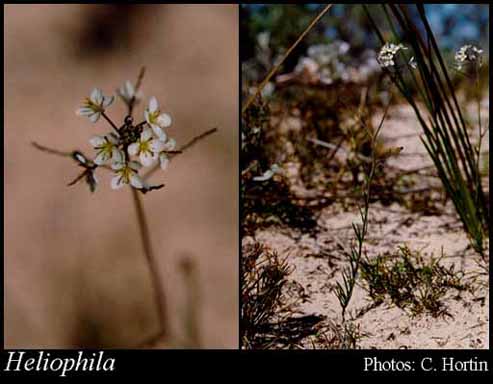- Reference
- Sp.Pl. [Linnaeus] p926 (1763)
- Name Status
- Current

Scientific Description
Family Brassicaceae.
Habit and leaf form. Herbs. Annual, or perennial. Leaves cauline. Stem internodes solid. To 0.3 m high. Mesophytic, or xerophytic. Leaves small to medium-sized; alternate; spiral; ‘herbaceous’; petiolate, or subsessile, or sessile; non-sheathing; foetid, or without marked odour; simple; epulvinate. Leaf blades entire; linear (to filiform), or obovate (to oblanceolate); one-veined, or pinnately veined. Leaves without stipules. Leaf blade margins entire. Leaves without a persistent basal meristem. Leaf anatomy. Hairs present (sparsely setose), or absent; glandular hairs absent; complex hairs absent. Branched hairs absent. Extra-floral nectaries absent.
Reproductive type, pollination. Fertile flowers hermaphrodite. Unisexual flowers absent. Plants hermaphrodite.
Inflorescence and flower features. Flowers aggregated in ‘inflorescences’; in racemes (usually), or in corymbs, or in fascicles (or clusters). The terminal inflorescence unit racemose. Inflorescences axillary. Flowers pedicellate; ebracteate; ebracteolate; minute to small; regular; 2 merous; cyclic. Floral receptacle with neither androphore nor gynophore. Free hypanthium absent. Hypogynous disk present; of separate members. Nectariferous glands 2. Perianth with distinct calyx and corolla; 8; 3 -whorled (K 2+2, C 4). Calyx present; 4 (decussate pairs in 2 whorls); 2 -whorled; polysepalous; decussate; regular. Sepals median sepals saccate. Corolla present; 4; 1 -whorled; alternating with the calyx; polypetalous; imbricate, or contorted; regular; white. Petals clawed. Androecial members definite in number. Androecium 6. Androecial members branched (in that the inner whorl of 4 is derived from only 2 primordia); free of the perianth; markedly unequal; free of one another; 2 -whorled (2+4). Androecium exclusively of fertile stamens. Stamens 6 (2 outer, 4 inner); tetradynamous; all more or less similar in shape; hypogynous, on receptacle, outer stamens lateral. Filaments appendiculate (sometimes, usually the outer), or not appendiculate (e.g. H. pusilla). Anthers basifixed; non-versatile; dehiscing via longitudinal slits; introrse; unilocular to bilocular; tetrasporangiate; appendaged, or unappendaged. Pollen shed as single grains. Gynoecium 2 carpelled. The pistil 2 celled. Gynoecium syncarpous; eu-syncarpous; superior. Ovary plurilocular; 2 locular. Locules secondarily divided by ‘false septa’. Gynoecium transverse. Ovary sessile. Gynoecium stylate. Styles 1; apical. Stigmas 1 (or 2); commissural; 1 - lobed, or 2 - lobed; capitate. Placentation parietal. Ovules 3–50 per locule (few to many); with ventral raphe; non-arillate; anatropous.
Fruit and seed features. Fruit 5–18 mm long; non-fleshy; dehiscent; a siliqua. Capsules valvular. Fruit 2 celled; few to many. Seeds 3–25 per locule (?—‘few to many’). Seed rows per locule 1. Seeds scantily endospermic, or non-endospermic; not mucous; small to medium sized. Embryo well differentiated. Cotyledons 2; folded; incumbent; diplecolobous. Embryo bent.
Physiology, biochemistry. Mustard-oils present.
Special features. Fruit body with no clear differentiation into valve and beak regions. Replum present and complete. Fruit bilaterally compressed, or terete; if compressed, compressed parallel with the septum. The inner (lateral) pair of sepals saccate basally for nectar storage. Petals not peculiarly elongated as in Stenopetalum. Nectariferous glands lateral only. Siliquae moniliform. Valves of the fruit neither winged nor keeled; conspicuously longitudinally veined; longitudinally 2 veined, or 3 veined.
Etymology. From the Greek for "sun" and "to love".